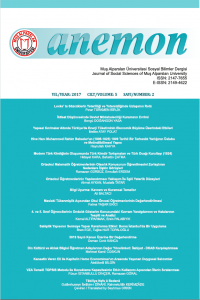Abstract
Mijara
nasîna nefsê, ji demên berê ve hem di navbera feylesofan û ehlê kelamê de û hem
di temamê dînan de cihekî muhim girtîye û nasîna nefsê di vê çarçoveyê de wekî
mifteya nasîna Heq (Xweda) û axiretê hatîye zanîn. Ev mijar, li şerqê û li
xerbê bi heman şêweyî nehatîye nirxandin. Di vê navberê de Îbnî Sîna eql bi
tevahî mucerred zanîye û ji ber ku nefs jî ji karên eqlî ye, nefs jî mucerred
qebûl kirîye. Ya muhim ev e ku çawa ev hêmana mucerred bi bedena maddî re
têkilî datîne. Lê belê Molla Sedra, li ser esasê hereketa cewherî qani’ bû ku
nefs, di destpêkê de cism e û nefs û beden bi hev ve girêdayî ne. Di encamê de,
li gorî nêrîna Hekîm Muderris Zunûzî, têkilîya nefsê bi bedenê re li ser
terkîba yekîtîyê pêk tê.
References
- Dînânî, G.İ., & Kerimzade, R. (1386 hş.). Rābite-i Nefs u Beden. Mecelle-i İlahiyāt u Huḳûḳ-i Dānişgāh-i Reżevı̇̄, (6), 3-28. (Erişim: 10.09.2016), http://www.ensani.ir/storage/Files/20120326104711-1100-180.pdf
Abstract
The matter of recognizing (know) the nafs (self) has come into prominence between the thinkers, theologians and religions from the old time to nowadays and that recognizing matter is evaluated as a key for knowing Al Haqq and akhirah (hereafter) at the same time. This matter is not addressed in the same way neither in the East nor in the West. By the way, Avicenna accepted the mind (aql) totally single and evaluated the nafs as an intangible entity since he thinks that nafs is one of the works of aql. The important point here is that: how an entity which is intangible could be connected with a body which is tangible. However Molla Sadra, referring to fundamentals of creation believed that nafs is tangible and it is in unity with body. All in all according to Hakim Muderris Zunuzi the connection of nafs with body is a connection which became a reality over the synthesis of unity.
References
- Dînânî, G.İ., & Kerimzade, R. (1386 hş.). Rābite-i Nefs u Beden. Mecelle-i İlahiyāt u Huḳûḳ-i Dānişgāh-i Reżevı̇̄, (6), 3-28. (Erişim: 10.09.2016), http://www.ensani.ir/storage/Files/20120326104711-1100-180.pdf
Details
| Journal Section | Translation |
|---|---|
| Authors | |
| Publication Date | July 1, 2017 |
| Acceptance Date | April 20, 2017 |
| Published in Issue | Year 2017 Volume: 5 Issue: 2 |
Anemon Muş Alparslan Üniversitesi Sosyal Bilimler Dergisi Creative Commons Atıf-GayriTicari 4.0 Uluslararası Lisansı (CC BY NC) ile lisanslanmıştır.


